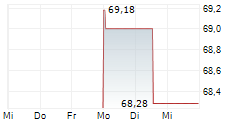NORTHAMPTON, MA / ACCESSWIRE / July 23, 2024 / Logitech
Logitech's approach to designing for sustainability prioritizes carbon reductions

Logitech Blog
Slow and steady wins the race. It's a great strategy if there is time for a calculated course of action. But, what if time is limited and action is needed now?
Logitech's accelerated actions are deliberate because time is of the essence. Strengthening and scaling the company's competencies in designing for sustainability not only prioritizes absolute carbon reductions but sets it apart in an industry traditionally known for energy-intensive manufacturing operations and growing electronic waste. To achieve its 2030 science-based emissions goals, Logitech has doubled down and expanded its design thinking across its entire product portfolio to design smarter, design with less, and design to advance progress across its entire product portfolio. It's called Design for Sustainability.
Logitech leverages the power of design to spur innovation and scale progress. It thoughtfully factors in environmental and social impacts as part of every design decision, starting from sourcing raw materials to a product's end-of-life stage. Designing with less means using fewer resources and eliminating unnecessary materials. Designing smarter means finding ways to improve performance with the innovation of alternative processes and materials. Designing for progress means reducing negative impacts and elevating social impacts to improve the products customers already love. Since 2019, Logitech has reduced its company carbon footprint by 58% and reduced its value chain emissions by 24% (compared to 2021). That's progress that has been achieved by accelerating and scaling design for sustainability capabilities.
Finding hidden impacts
Let's take a closer look at how simple design modifications at the product level can lead to significant impact across the entire portfolio. Logitech's size is an advantage because it allows it to be agile and fast in taking action, but large enough to create impact and influence other industry partners.
One example is its Next Life Plastics program. Logitech uses post-consumer recycled plastic at scale to repurpose end-of-life plastic, reduce its carbon footprint, and shift from virgin resources to more circular materials. A remarkable 73% of Logitech products incorporate Next Life Plastics, giving a second life to end-of-life electronics. Most importantly, there is no compromise on quality and people have a wide variety of designs and 40+ colors to choose from. Gone are the days of recycled plastic in only shades of gray or black. In 2023, Logitech eliminated over 25,000 tCO2e by manufacturing with recycled plastic vs. virgin plastic. That's the equivalent of driving over 2,300 times around the globe in an average gasoline-powered car.
Another example is low-carbon aluminum, which is produced with renewable energy instead of fossil fuel energy. Logitech uses aluminum in keyboards, tablet accessories, gaming racing wheels, gaming headsets, webcams, and business conference room cameras. 66 product lines across its portfolio now use low-carbon aluminum, saving 13,000 tCO2e in 2023. That's the same amount of energy it takes to fully charge nearly 780 million smartphones and maintain that charge throughout the day.
Logitech also manufactures in factories that purchase renewable electricity and in 2023 it partnered with a utility vendor to install solar panels across the roof of its main production facility. It has incorporated smart battery features to lower battery consumption and optimize product use. Recycled fabrics are used where possible in its newest designs, including speakers. Nearly 20% of products use FSCTM-certified paper packaging, including 73% of new product introductions. Transitioning away from single-use plastic packaging toward paper packaging supports circular alternatives and enables curbside recycling where facilities exist.
Reducing carbon footprint
Accelerate and scale. That's the approach driving Logitech's success in reducing its carbon footprint. When nearly 60% of its overall company footprint comes from sourcing and manufacturing its products, finding the hidden impacts quickly and scaling solutions to reduce them will accelerate change.
Gone are the days of 'slow and steady wins the race'. Accelerate and scale to reduce carbon emissions now and increase the pace of change is how Logitech operates.
Learn more about Logitech's approach to Design for Sustainability on its website and discover more product-specific examples of how designing for sustainability is accelerating carbon reductions in the FY24 Impact Report. Look for case studies that showcase product carbon footprint reductions in action including Wave Keys, one of Logitech's wireless ergonomic keyboards; Zone Wireless 2, an AI-powered headset; Casa Pop-Up Desk, a foldaway kit with laptop stand, keyboard, and touchpad; Lift, an ergonomic vertical mouse; Yeti Orb, Logitech G's premium gaming microphone; and others.
Footnotes:
According to https://www.epa.gov/energy/greenhouse-gas-equivalencies-calculatorresults 25,000 tCO2e equates to 58,044,653 miles driven by an average gasoline power passenger vehicle. According to https://www.space.com/17638-how-big-is-earth.html, the equatorial circumference of Earth is 24,901 miles.
According to https://www.epa.gov/energy/greenhouse-gas-equivalencies-calculatorresults 13,000 tCO2e equates to 778,561,236 smartphones charged (https://www.epa.gov/energy/greenhouse-gases-equivalencies-calculator-calculations-and-referencessmartphones)
View additional multimedia and more ESG storytelling from Logitech on 3blmedia.com.
Contact Info:
Spokesperson: Logitech
Website: https://www.3blmedia.com/profiles/logitech
Email: info@3blmedia.com
SOURCE: Logitech
View the original press release on accesswire.com



